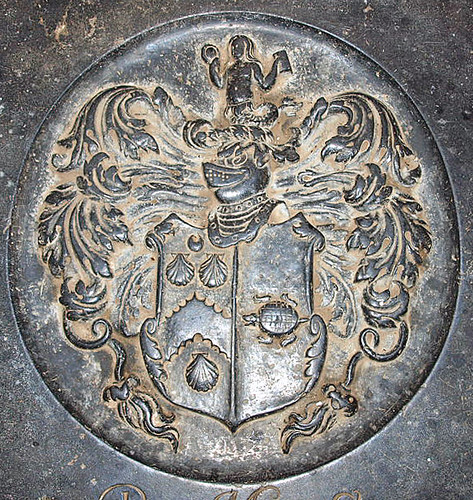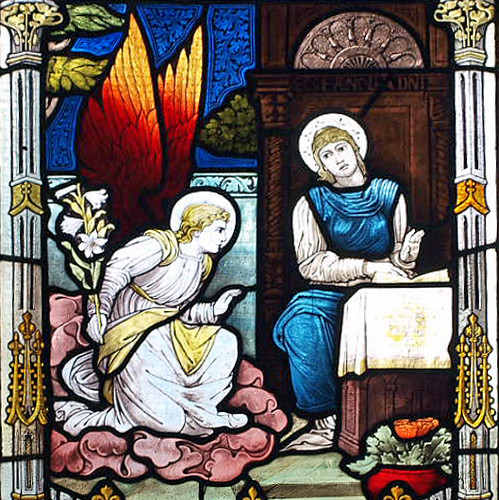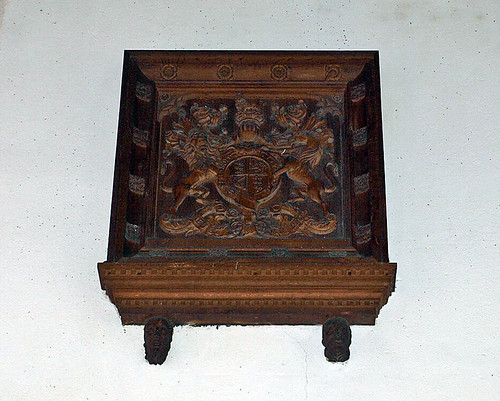ST JOHN BAPTIST. Round tower, round to the top. Unmoulded arch to the nave. Unmoulded square imposts, with two thin incised parallel horizontal lines. Nave and chancel Perp. The pretty piscina with ogee arch, and in the spandrels a flower and a face with tongue stuck out, is considered Dec by Cautley. - FONT. Octagonal. Against the stem four lions, against the bowl four lions and four demi-figures of angels. - PLATE. Elizabethan Chalice. - MONUMENTS. Elizabethan monument without effigy or inscription. Tomb-chest with pilasters and shields. Back wall with pilasters and a four-centred arch. Oblong panel with coat of arms. The monument probably commemorates Richard Garneys, who bought Boyland Hall in 1571. - Margaret Gostling d. 1723, by Thomas Stayner. Tablet with barley-sugar columns.
MORNINGTHORPE. It lies tucked away in charming lanes a mile and more from the Roman road between Norwich and Ipswich, and has fine old Tudor houses among lovely trees. One charming Elizabethan house facing the church has quaint chimney stacks, a spreading cedar in its garden, and a barn with a finely patterned thatch. Another Elizabethan house near the church stands in its park, and was the home of the Howes, whose memorials tell us that John made the world better for his living, that his son John was a merciful man, that Thomas was rector for 51 years of last century, and that Edward was 12 years MP for Norfolk.
Under a recessed tomb in the chancel, with carvings of a spade, pickaxe, hourglass, skull and crossbones, sleeps Martha Garney, who died in 1694. She was the last of the Garneys of Boyland Hall, yet another Elizabethan house which stands in a valley north of the village, the River Tas flowing through its grounds. It is a big grey house with many chimneys, and has over one entrance a bust of Queen Elizabeth.
Small like the village, the church is neat and simple and aisleless, and comes chiefly from the 15th century except for the round tower with its uneven walls, which was built by the Normans. Its stout arch is Norman, but the west window and those of the belfry were inserted 600 years ago, and the parapet is modern. A medieval mass dial is in the wall. The old font has lions at the foot and winged angels under the bowl. A pretty 15th-century piscina has a pinnacled canopy, Tudor rose and a leopard’s face in the spandrels, and a mix-leaved drain. Over the tower arch the royal arms are boldly carved out of a solid block of oak, and painted. Modern days have given the church roofs adorned with angels and flower bosses, and enriched the nave and chancel with poppyhead seats, one of which a fine John the Baptist in camel hair and mantle.
Under a recessed tomb in the chancel, with carvings of a spade, pickaxe, hourglass, skull and crossbones, sleeps Martha Garney, who died in 1694. She was the last of the Garneys of Boyland Hall, yet another Elizabethan house which stands in a valley north of the village, the River Tas flowing through its grounds. It is a big grey house with many chimneys, and has over one entrance a bust of Queen Elizabeth.
Small like the village, the church is neat and simple and aisleless, and comes chiefly from the 15th century except for the round tower with its uneven walls, which was built by the Normans. Its stout arch is Norman, but the west window and those of the belfry were inserted 600 years ago, and the parapet is modern. A medieval mass dial is in the wall. The old font has lions at the foot and winged angels under the bowl. A pretty 15th-century piscina has a pinnacled canopy, Tudor rose and a leopard’s face in the spandrels, and a mix-leaved drain. Over the tower arch the royal arms are boldly carved out of a solid block of oak, and painted. Modern days have given the church roofs adorned with angels and flower bosses, and enriched the nave and chancel with poppyhead seats, one of which a fine John the Baptist in camel hair and mantle.



No comments:
Post a Comment